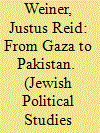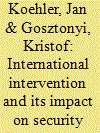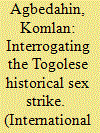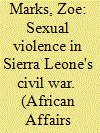|
|
|
Sort Order |
|
|
|
Items / Page
|
|
|
|
|
|
|
| Srl | Item |
| 1 |
ID:
124368


|
|
|
|
|
| Publication |
2011.
|
| Summary/Abstract |
On the one hand, there is Israel's targeted killing (TK) policy which has been conducted in almost full compliance with Human Rights Watch's stated test, executed with remarkable transparency, and has achieved unprecedented levels of intelligence accuracy, with less than one civilian fatality average per TK. In over 95 percent of Israeli TKs neither the identity of the targeted militant nor his involvement in hostilities was subject to dispute. On the other hand, there is a Western TK policy which in many cases did not comply with HRW's stated test and is conducted behind a cloak of systemic and deliberate opacity, with virtually no public scrutiny. Due to faulty or compromised intelligence, this policy resulted in a large number of TKs where the target was not in fact at the targeted location, and with a ratio of more than ten civilian fatalities per TK.
|
|
|
|
|
|
|
|
|
|
|
|
|
|
|
|
| 2 |
ID:
133140


|
|
|
|
|
| Publication |
2014.
|
| Summary/Abstract |
The challenge of building a security sector effective in terms of protecting the population and the state from challengers, and which at the same time fulfils minimum standards of good governance, was a daunting one in Afghanistan. These difficulties were compounded by what in hindsight seem to be obvious mistakes on the part of the intervention. In our paper, we investigate how security sector building fared under such adverse conditions in north-east Afghanistan. We find that in spite of the formidable challenges and the mistakes made by the international intervention, it did not fail completely. Neither did it succeed. Based on the results of quantitative surveys and qualitative research, we suggest that (a) the international intervention was partly successful in building up Afghan National Security Forces - both as a fighting force and in terms of security sector institutions that are restrained to some extent by the rule of law; (b) the problems caused by setting up informal local militias (violent feuds, criminality, human rights abuses and extortion of the population) could be partly mitigated by transforming them into an official local police programme.
|
|
|
|
|
|
|
|
|
|
|
|
|
|
|
|
| 3 |
ID:
128311


|
|
|
|
|
| Publication |
2014.
|
| Summary/Abstract |
This article, is about an attempt by women in Togo to use a sex strike to end the country's political impasse. The concept dates back to the ancient Greek comedy Lysistrata by Aristophanes, first presented publicly in 411 b.c. More recently, a sex strike had been used with some success in Liberia that inspired Togolese women to attempt this method of non-violent action. The Togolese experiment, however, ended in failure. This article discusses reasons for the failure, including inadequate preparation and miscommunication and the neglect of the political, economic, and social context of Togo.
|
|
|
|
|
|
|
|
|
|
|
|
|
|
|
|
| 4 |
ID:
133103


|
|
|
|
|
| Publication |
2014.
|
| Summary/Abstract |
The expansion of Chinese activities in Africa has been accompanied by a growing number of young Chinese women migrants engaged in prostitution, transforming the red-light districts of some African cities from markets almost entirely monopolized by local sex workers into highly competitive Chinese commercial sexualized sites. In Cameroon, disgruntled local sex workers now point to a 'Chinese sexual invasion' and blame young Chinese women for the decline in their business. This article explores some of the remarkable tactics devised by local sex workers in Douala to deal with the 'unfair competition' represented by Chinese sex workers. These tactics include the production of extremist discourses that construe Chinese sex workers as economic predators, and characterize them as dangerous putes sorcières (bitch-witches). The article concludes that the pervasive idiom of occultism, embodied by the concepts of "magic body" and "cursed sex" that permeate much of the popular imagination of Chinese sex labourers in Cameroon, reflects a broader disenchantment with recent China-Africa cooperation, which is increasingly perceived as an attempt by China to control Africa's immense natural resources under the guise of mutually beneficial relations.
|
|
|
|
|
|
|
|
|
|
|
|
|
|
|
|
| 5 |
ID:
131812


|
|
|
|
|
| Publication |
2014.
|
| Summary/Abstract |
Rape and sexual violence loom large in the study of civil war in Africa. Sierra Leone has been one of the most prominent cases for establishing rape as a 'weapon of war', yet little is known about how sexual violence was understood by commanders or combatants within the Revolutionary United Front (RUF). Mainstream analyses of armed groups and civil war rarely engage with gender dynamics, despite their centrality to war making, power, and violence; and research that does focus on sexual violence tends to overlook the complex internal dynamics of the groups responsible. This article examines the internal gender dynamics of the RUF from the perspective of male and female members in seeking to understand the perpetration of sexual violence. It shows that both formal and informal laws and power structures existed to regulate gender relations and control sexual behaviour within the group. It identifies four categories of women - non-wives, unprotected wives, protected wives, and senior women - and shows that women's interests and experiences of sexual violence were not homogeneous, but were instead shaped by their status within the group. In this way, sexual violence, examined in social context, provides an entry point for understanding how power, protection, and access to resources are brokered in rebellion.
|
|
|
|
|
|
|
|
|
|
|
|
|
|
|
|
|
|
|
|
|